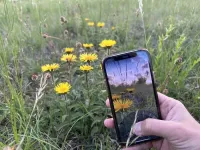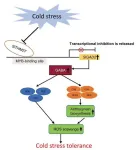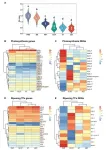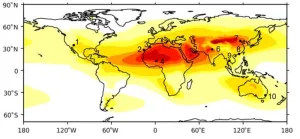(Press-News.org) Plants are known to respond to seasonal changes by budding, leafing, and flowering. As climate change stands to shift these so-called phenological stages in the life cycle of plants, access to data about phenological changes – from many different locations and in different plants – can be used to draw conclusions about the actual effects of climate change. However, conducting such analyses require a large amount of data and data collection of this scale would be unthinkable without the help of citizen scientists. “The problem is that the quality of the data suffers when fewer people engage as citizen scientists and stop collecting data,” says first author Karin Mora, research fellow at Leipzig University and iDiv.
Mobile apps like Flora Incognita could help solve this issue. The app allows users to identify unknown wild plants within a matter of seconds. “When I take a picture of a plant with the app, the observation is recorded with the (exact) location as well as a time stamp,” explains co-author Jana Wäldchen from the Max Planck Institute for Biogeochemistry (MPI-BGC), who developed the app with colleagues from TU Ilmenau. “Millions of time-stamped plant observations from different regions have been collected by now.” Although satellite data also records the phenology of entire ecosystems from above, they do not provide information about the processes taking place on the ground.
Plants show synchronised response
The researchers developed an algorithm that draws on almost 10 million observations of nearly 3,000 plants species identified between 2018 and 2021 in Germany by users of Flora Incognita. The data show that each individual plant has its own cycle as to when it begins a flowering or growth phase. Furthermore, the scientists were able to show that group behaviour arises from the behaviour of individuals. From this, they were able to derive ecological patterns and investigate how these change with the seasons. For example, ecosystems by rivers differ from those in the mountains, where phenological events start later.
The algorithm also accounts for the observational tendencies of Flora Incognita users, whose data collection is far from systematic. For example, users record more observations on the weekend and in densely populated areas. “Our method can automatically isolate these effects from the ecological patterns,” Karin Mora explains. “Fewer observations don’t necessarily mean that we can’t record the synchronisation. Of course, there are very few observations in the middle of winter, but there are also very few plants that can be observed during that time.”
It is known that climate change is causing seasonal shifts – for example, spring is arriving earlier and earlier. How this affects the relationship between plants and pollinating insects and therefore potentially also food security is still being subject to further research. The new algorithm can now be used to better analyse the effects of these changes on the plant world.
This study was funded by the Deutsche Forschungsgemeinschaft (DFG; FZT-118) and the iDiv Flexpool.
END
How a plant app helps identify the consequences of climate change
By leveraging millions of time-stamped observations, researchers can identify plant rhythms and ecological patterns year-round
2024-07-09
ELSE PRESS RELEASES FROM THIS DATE:
Tomato triumph: genetic key to chill-proof crops unveiled
2024-07-09
In a significant advancement for agricultural biotechnology, researchers have identified a genetic mechanism that enhances the cold tolerance of tomatoes. This breakthrough is pivotal for cultivating crops in cooler climates, ensuring stable yields and bolstering global food security. The study focuses on the SlGAD2 gene, which, when overexpressed, elevates the plant's γ-aminobutyric acid (GABA) levels, boosts antioxidant activities, and stimulates anthocyanin production, collectively improving cold resilience.
Tomatoes play a vital role in global agriculture but are susceptible ...
Scientists exploring potential new treatments for glioblastoma
2024-07-09
A new approach to treating the most malignant type of brain cancer – glioblastoma – has shown strong promise in pre-clinical settings, raising hopes of increasing current average survival rates beyond 18 months.
Targeted alpha therapy (TAT) is emerging as a potential additional treatment for glioblastoma (GB), a disease which has confounded oncologists for decades due to its aggressive nature and strong resistance to existing therapies.
The current standard treatment for GB is surgery, followed by external beam radiotherapy and the chemotherapy drug, temozolomide. However, survival rates of less than 5-10% at five years have prompted researchers to explore ...
Tomato Time capsule: postharvest treatments and their role in ripening dynamics
2024-07-09
Tomato fruit ripening, a process initiated by key gene demethylation, is significantly influenced by postharvest handling practices. These practices, while extending shelf life, can alter ripening dynamics and affect fruit quality. This study explores the impact of various postharvest treatments on the fruit's methylome and transcriptome, shedding light on how physiological and molecular changes interplay to determine the final quality of tomatoes.
Postharvest handling practices, such as refrigeration and modified atmosphere storage, are commonly used to extend the shelf life of tomatoes. However, these methods can negatively impact fruit quality, ...
Innovative, highly accurate AI model can estimate lung function just by using chest x-rays
2024-07-09
If there is one medical exam that everyone in the world has taken, it’s a chest x-ray. Clinicians can use radiographs to tell if someone has tuberculosis, lung cancer, or other diseases, but they can’t use them to tell if the lungs are functioning well.
Until now, that is.
In findings published in The Lancet Digital Health, a research group led by Associate Professor Daiju Ueda and Professor Yukio Miki at Osaka Metropolitan University’s Graduate School of Medicine has developed an artificial intelligence model that can estimate lung function from chest radiographs with high accuracy.
Conventionally, ...
University of Cincinnati, Swing Therapeutics study: Mobile app therapy leads to significant improvement in fibromyalgia management
2024-07-09
New research led by the University of Cincinnati and Swing Therapeutics found that a self-guided smartphone-based behavioral therapy led to significant improvements for patients with fibromyalgia.
The multicenter, randomized controlled trial tested Stanza, a smartphone app that delivers acceptance and commitment therapy (ACT), a type of cognitive behavioral therapy recommended by international clinical guidelines for fibromyalgia management, with the results of the study published July 8 in The Lancet.
Fibromyalgia is a chronic pain condition that affects an estimated 10 million Americans, a majority ...
Anxiety and depression a more common consequence of cardiac arrest for women than for men
2024-07-09
Cardiac arrests affect around 350,000 people in Europe each year with less than 20% surviving an out of hospital cardiac arrest. Research from Amsterdam UMC shows that women who survive consequently have greater rates of anxiety and depression. Furthermore, both men and women are affected by negative population-wide changes in socioeconomic status as they age. Suggesting more support is necessary for those who have suffered a cardiac arrest. These results are published today in Circulation: Cardiovascular Quality & Outcomes.
"We looked at many factors to determine the five-year consequences of a cardiac arrest, here we saw, most significantly, a 50% ...
Engine wear risk as planes swallow more dust waiting to land
2024-07-09
Planes flying into one of the world's busiest airports are ingesting around 10kg of dust per 1,000 flights - with most of this dust ingested while they are waiting to land, new research has revealed.
Scientists used 17 years of ECMWF atmospheric data and data from the CALIPSO satellite to calculate the quantity of sand and dust swallowed by jet engines at ten major international airports located in desert regions or subject to seasonal dust storms.
The global study, published today (Tuesday, 9 July) in the journal Natural Hazards and Earth System Sciences, ...
Coral reefs: battlegrounds for survival in a changing climate
2024-07-09
(Santa Barbara, Calif.) — Coral reefs, those vibrant underwater cities, stand on the precipice of collapse. While rising ocean temperatures and coral bleaching grab headlines, a new essay in Current Biology reveals a hidden layer of complexity in this fight for survival: the often-overlooked roles of the reefs’ smallest inhabitants.
Scientists have long understood the vital partnership between corals and their symbiotic algae, but work by researchers at UC Santa Barbara and University of Georgia highlights how the fate of entire reefs may hinge ...
Study: Telehealth builds autonomy, trust in treating addiction
2024-07-09
Even as the nation’s opioid epidemic continues to ravage families and communities nationwide — with more than 100,000 Americans dying of drug overdoses each year — stigma remains a barrier for many people accessing treatment for addiction.
A new study from Oregon Health & Science University suggests telehealth may be an important antidote to overcoming stigma and reducing barriers for people seeking out the treatment they need.
The study, published recently in the Harm Reduction Journal, compiled in-depth interviews with 30 people treated for substance use disorder ...
New carbon storage technology is fastest of its kind
2024-07-09
A new way to store carbon captured from the atmosphere developed by researchers from The University of Texas at Austin works much faster than current methods without the harmful chemical accelerants they require.
In new research published in ACS Sustainable Chemistry & Engineering, the team developed a technique for ultrafast formation of carbon dioxide hydrates. These unique ice-like materials can bury carbon dioxide in the ocean, preventing it from being released into the atmosphere.
“We’re staring at a huge challenge — finding a way ...
LAST 30 PRESS RELEASES:
Post-stroke injection protects the brain in preclinical study
Cardiovascular risk score predicts multiple eye diseases
Health: estimated one in ten British adults used or interested in GLP-1 medications for weight loss
Exercise to treat depression yields similar results to therapy
Whooping cough vaccination for pregnant women strengthens babies’ immune system
Dramatic decline in new cases of orphanhood in Uganda driven by HIV treatment and prevention programs
Stopping weight loss drugs linked to weight regain and reversal of heart health markers
Higher intake of food preservatives linked to increased cancer risk
Mass General Brigham–developed cholera vaccine completes phase 1 trial
First experimental validation of a “150-year-old chemical common sense” direct visualization of the molecular structural changes in the ultrafast anthracene [4+4] photocycloaddition reaction
Lack of support for people on weight loss drugs leaves them vulnerable to nutritional deficiencies, say experts
Dogs’ dinners can have greater climate impact than owners’
Are you ready to swap salmon for sprats and sardines?
1.6 million UK adults used weight loss drugs in past year
American College of Cardiology comments on new dietary guidelines for Americans
American Society of Gene & Cell Therapy and Orphan Therapeutics Accelerator partner to advance and commercialize promising rare disease treatments
One in 14 patients having day case surgery have new or worse chronic pain 3 months after their operation
New study highlights link between eviction rates and gun violence
Heatwaves heat up soil but not toxin levels in rice, study finds
Digital modeling reveals where construction carbon emissions really come from
Turning farm waste into water filters
New study shows how the spleen helps the immune system accept a transplant
New Mayo Clinic study advances personalized prostate cancer education with an EHR-integrated AI agent
Researchers identify novel therapeutic target to improve recovery after nerve injury
Microbes in breast milk help populate infant gut microbiomes
Reprogramming immunity to rewrite the story of Type 1 diabetes
New tool narrows the search for ideal material structures
Artificial saliva containing sugarcane protein helps protect the teeth of patients with head and neck cancer
Understanding the role of linear ubiquitination in T-tubule biogenesis
Researchers identify urban atmosphere as primary reservoir of microplastics
[Press-News.org] How a plant app helps identify the consequences of climate changeBy leveraging millions of time-stamped observations, researchers can identify plant rhythms and ecological patterns year-round







